Effect of the Combined Intervention with Passive Whole-Body Vibration and Auriculotherapy on the Quality of Life of Individuals with Knee Osteoarthritis Assessed by the WHOQOL-Bref: A Multi-Arm Clinical Trial
Abstract
1. Introduction
2. Methods
2.1. Individuals and Ethics Committee
2.2. Sample Size
2.3. Inclusion and Exclusion Criteria
2.4. Intervention and Control Groups
2.5. Passive Whole-Body Vibration Intervention
2.6. Auricular Intervention
2.7. Combined Intervention
3. Outcome Measures
Statistical Analysis
4. Results
5. Discussion
6. Conclusions
Author Contributions
Funding
Conflicts of Interest
References
- SBR. Osteoartrite. (Artrose). Available online: http://www.reumatologia.com.br/www/2016/02/01/osteoartrite-artrose/ (accessed on 22 September 2017).
- Man, G.S.; Mologhianu, G. Osteoarthritis pathogenesis—A complex process that involves the entire joint. J. Med. Life 2014, 7, 37–41. [Google Scholar]
- Fibel, K.H.; Hillstrom, H.J.; Halpern, B.C. State-of-the-Art management of knee osteoarthritis. World J. Clin. Cases 2015, 3, 89–101. [Google Scholar] [CrossRef]
- Holla, J.F.; van der Leeden, M.; Heymans, M.W.; Roorda, L.D.; Bierma-Zeinstra, S.M.; Boers, M.; Lems, W.F.; Steultjens, M.P.; Dekker, J. Three trajectories of activity limitations in early symptomatic knee osteoarthritis: A 5-year follow-up study. Ann. Rheum. Dis. 2013, 73, 1369–1375. [Google Scholar] [CrossRef]
- Lane, N.E.; Brandt, K.; Hawker, G.; Peeva, E.; Schreyer, E.; Tsuji, W.; Hochberg, M.C. OARSI-FDA initiative: Defining the disease state of osteoarthritis. Osteoarthr. Cartil. 2011, 195, 478–482. [Google Scholar] [CrossRef]
- Cutolo, M.; Berenbaum, F.; Hochberg, M.; Punzi, L.; Reginster, J.-Y.Y. Commentary on Recent Therapeutic Guidelines for Osteoarthritis. In Seminars in Arthritis and Rheumatism; W.B. The Saunders Company: Philadelphia, PA, USA, 2015; Volume 44, pp. 611–617. [Google Scholar] [CrossRef]
- Araujo, I.L.A.; Castro, M.C.; Daltro, C.; Matos, M.A. Quality of Life and Functional Independence in Patients with Osteoarthritis of the Knee. Knee Surg. Relat. Res. 2016, 283, 19–24. [Google Scholar] [CrossRef] [PubMed]
- Farr Ii, J.; Miller, L.E.; Block, J.E. Quality of life in patients with knee osteoarthritis: A commentary on nonsurgical and surgical treatments. Open Orthop. J. 2013, 7, 619–623. [Google Scholar] [CrossRef] [PubMed]
- Hochberg, M.C.; Altman, R.D.; April, K.T.; Benkhalti, M.; Guyatt, G.; McGowan, J.; Towheed, T.; Welch, V.; Wells, G.; Tugwell, P. American College of Rheumatology 2012 recommendations for the use of nonpharmacologic and pharmacologic therapies in osteoarthritis of the hand, hip, and knee. Arthritis Care Res. 2012, 644, 465–474. [Google Scholar] [CrossRef] [PubMed]
- Zhang, W.; Nuki, G.; Moskowitz, R.W.; Abramson, S.; Altman, R.D.; Arden, N.K.; Bierma-Zeinstra, S.; Brandt, K.D.; Croft, P.; Doherty, M.; et al. OARSI recommendations for the management of hip and knee osteoarthritis. Part III: Changes in evidence following systematic cumulative update of research published through January 2009. Osteoarthr. Cartil. 2010, 184, 476–499. [Google Scholar] [CrossRef] [PubMed]
- Fransen, M.; Mcconnell, S.; Harmer, A.R.; Esch MVan Der Simic, M.; Bennell, K.L. Exercise for osteoarthritis of the knee: A Cochrane systematic review. Br. J. Sports Med. 2015, 49, 1554–1557. [Google Scholar] [CrossRef]
- Liu, Y.-H.; Wei, I.-P.; Wang, T.-M.; Lu, T.-W.; Lin, J.-G. Immediate Effects of Acupuncture Treatment on Intra- and Inter-Limb Contributions to Body Support During Gait in Patients with Bilateral Medial Knee Osteoarthritis. Am. J. Chin. Med. 2017, 4501, 23–35. [Google Scholar] [CrossRef]
- Hou, P.W.; Hsu, H.C.; Lin, Y.W.; Tang, N.Y.; Cheng, C.Y.; Hsieh, C.L. The history, mechanism, and clinical application of auricular therapy in traditional Chinese medicine. Evid. Based Complement. Altern. Med. 2015, 2015. [Google Scholar] [CrossRef]
- Suen, L.K.P.; Yeh, C.H.; Yeung, S.K.W. Erratum to Using auriculotherapy for osteoarthritic knee among elders: A double-blinded randomised feasibility study. BMC Complement. Altern. Med. 2016, 161, 257. [Google Scholar] [CrossRef] [PubMed]
- Round, R.; Litscher, G.; Bahr, F. Auricular acupuncture with laser. Evid. Based Complement. Altern. Med. 2013, 2013. [Google Scholar] [CrossRef] [PubMed]
- De Oliveira Melo, M.; Pompeo, K.D.; Baroni, B.M.; Vaz, M.A. Effects of neuromuscular electrical stimulation and low-level laser therapy on neuromuscular parameters and health status in elderly women with knee osteoarthritis: A randomized trial. J. Rehabil. Med. 2016, 483, 293–299. [Google Scholar] [CrossRef]
- Prioreschi, A.; Tikly, M.; McVeigh, J.A. A three month controlled intervention of intermittent whole body vibration designed to improve functional ability and attenuate bone loss in patients with rheumatoid arthritis. BMC Musculoskelet. Disord. 2014, 151, 403. [Google Scholar] [CrossRef][Green Version]
- Ferreira, R.; Duarte, J.; Gonçalves, R. Non-pharmacological and non-surgical interventions to manage patients with knee osteoarthritis: An umbrella review. Acta Reum. Port. 2018, 43, 182–200. [Google Scholar]
- Neto, S.B.; Marconi, E.M.; Kutter, C.R.; Frederico, E.H.; de Paiva, P.D.; Meyer, P.F.; Chang, S.; Sá-Caputo, D.; Bernardo-Filho, M. Beneficial effects of whole body mechanical vibration alone or combined with auriculotherapy in the pain and in flexion of knee of individuals with knee osteoarthritis. Acupunct. Electro Ther. Res. 2017, 423, 185–201. [Google Scholar] [CrossRef]
- Rauch, F.; Sievanen, H.; Boonen, S.; Cardinale, M.; Degens, H.; Felsenberg, D.; Roth, J.; Schoenau, E.; Verschueren, S.; Rittweger, J. Reporting whole-body vibration intervention studies: Recommendations of the International Society of Musculoskeletal and Neuronal Interactions. J. Musculoskelet. Neuronal Interact. 2010, 103, 93–98. [Google Scholar]
- Rittweger, J. Vibration as an exercise modality: How it may work, and what its potential might be. Eur. J. Appl. Physiol. 2010, 1085, 877–904. [Google Scholar] [CrossRef]
- Bokaeian, H.R.; Bakhtiary, A.H.; Mirmohammadkhani, M.; Moghimi, J. The effect of adding whole body vibration training to strengthening training in the treatment of knee osteoarthritis: A randomized clinical trial. J. Bodyw. Mov. Ther. 2016, 202, 334–340. [Google Scholar] [CrossRef]
- Park, Y.G.; Kwon, B.S.; Park, J.W.; Cha, D.Y.; Nam, K.Y.; Sim, K.B.; Chang, J.; Lee, H.J. Therapeutic Effect of Whole Body Vibration on Chronic Knee Osteoarthritis. Ann. Rehabil. Med. 2013, 374, 505–515. [Google Scholar] [CrossRef] [PubMed]
- Wang, P.; Yang, X.; Yang, Y.; Yang, L.; Zhou, Y.; Liu, C.; Reinhardt, J.D.; He, C. Effects of whole body vibration on pain, stiffness and physical functions in patients with knee osteoarthritis: A systematic review and meta-analysis. Clin. Rehabil. 2015, 2910, 939–951. [Google Scholar] [CrossRef] [PubMed]
- Salmon, J.R.; Roper, J.A.; Tillman, M.D. Does Acute Whole-Body Vibration Training Improve the Physical Performance of People with Knee Osteoarthritis? J. Strength Cond. Res. 2012, 2611, 983–989. [Google Scholar] [CrossRef] [PubMed]
- Avelar, N.C.; Simão, A.P.; Tossige-Gomes, R.; Neves, C.D.; Rocha-Vieira, E.; Coimbra, C.C.; Lacerda, A.C. The Effect of Adding Whole-Body Vibration to Squat Training on the Functional Performance and Self-Report of Disease Status in Elderly Patients with Knee Osteoarthritis: A Randomized, Controlled Clinical Study. J. Altern. Complement. Med. 2011, 1712, 149–155. [Google Scholar] [CrossRef]
- Wang, P.; Yang, L.; Liu, C.; Wei, X.; Yang, X.; Zhou, Y.; Jiang, H.; Lei, Z.; Reinhardt, J.D.; He, C. Effects of Whole Body Vibration Exercise associated with Quadriceps Resistance Exercise on functioning and quality of life in patients with knee osteoarthritis: A randomized controlled trial. Clin. Rehabil. 2016, 3011, 1074–1087. [Google Scholar] [CrossRef]
- Wang, P.; Yang, L.; Li, H.; Lei, Z.; Yang, X.; Liu, C.; Jiang, H.; Zhang, L.; Zhou, Z.; Reinhardt, J.D.; et al. Effects of whole-body vibration training with quadriceps strengthening exercise on functioning and gait parameters in patients with medial compartment knee osteoarthritis: A randomised controlled preliminary study. Physiother. J. 2016, 1021, 86–92. [Google Scholar] [CrossRef]
- Moreira-Marconi, E.; Dionello, C.F.; Morel, D.S.; Sá-Caputo, D.C.; Souza-Gonçalves, C.R.; Paineiras-Domingos, L.L.; Guedes-Aguiar, E.O.; Marin, P.J.; del Pozo Cruz, B.; Bernardo-Filho, M. Could whole body vibration exercises influence the risk factors for fractures in women with osteoporosis? Osteoporos. Sarcopenia 2016. [Google Scholar] [CrossRef]
- Dionello, C.F.; Sá-Caputo, D.; Pereira, H.V.; Sousa-Gonçalves, C.R.; Maiworm, A.I.; Morel, D.S.; Moreira-Marconi, E.; Paineiras-Domingos, L.L.; Bemben, D.; Bernardo-Filho, M. Effects of whole body vibration exercises on bone mineral density of women with postmenopausal osteoporosis without medications: Novel findings and literature review. J. Musculoskelet. Neuronal Interact. 2016, 163, 193. [Google Scholar]
- Paineiras-Domingos, L.L.; Sá-Caputo, D.D.; Moreira-Marconi, E.; Morel, D.S.; da Fontoura Dionello, C.; Sousa-Gonçalves, C.R.; Frederico, É.H.; Marín, P.J.; Tamini, S.; Sartorio, A.; et al. Can whole body vibration exercises affect growth hormone concentration? A systematic review. Growth Factors 2017, 35, 189–200. [Google Scholar] [CrossRef]
- Sá-Caputo, D.D.; Ronikeili-Costa, P.; Carvalho-Lima, R.P.; Bernardo, L.C.; Bravo-Monteiro, M.O.; Costa, R.; Moraes-Silva, J.D.; Paiva, D.N.; Machado, C.B.; Mantilla-Giehl, P.; et al. Whole Body Vibration Exercises and the Improvement of the Flexibility in Patient with Metabolic Syndrome. Rehabil. Res. Pract. 2014, 2014, 1–10. [Google Scholar] [CrossRef]
- Asher, G.N.; Jonas, D.E.; Coeytaux, R.R.; Reilly, A.C.; Loh, Y.L.; Motsinger-Reif, A.A.; Winham, S.J. Auriculotherapy for Pain Management: A Systematic Review and Meta-Analysis of Randomized Controlled Trials. J. Altern. Complement. Med. 2010, 1610, 97–108. [Google Scholar] [CrossRef]
- Usichenko, T.I.; Dinse, M.; Hermsen, M.; Witstruck, T.; Pavlovic, D.; Lehmann, C. Auricular acupuncture for pain relief after total hip arthroplasty—A randomized controlled study. Pain 2005, 1143, 320–327. [Google Scholar] [CrossRef] [PubMed]
- Li, M.K.; Lee, T.F.D.; Suen, K.P.L. Complementary effects of auricular acupressure in relieving constipation symptoms and promoting disease-specific health-related quality of life: A randomized placebo-controlled trial. Complement. Ther. Med. 2014, 222, 66–77. [Google Scholar] [CrossRef]
- Yeh, M.L.; Chang, Y.C.; Huang, Y.Y.; Lee, T.Y. A randomized controlled trial of auricular acupressure in heart rate variability and quality of life for hypertension. Complement. Ther. Med. 2015, 232, 200–209. [Google Scholar] [CrossRef]
- Miot, H.A. Tamanho da amostra em estudos clínicos e experimentais. J. Vasc. Bras. 2011, 10, 275–278. [Google Scholar] [CrossRef]
- Carvalho-Lima, R.P.; Sá-Caputo, D.C.; Moreira-Marconi, E.; Dionello, C.; Paineiras-Domingos, L.L.; Sousa-Gonçalves, C.R.; Morel, D.S.; Frederico, E.H.; Neves, M.F.; Oliveira, R.; et al. Quality of life of patients with metabolic syndrome is improved after whole body vibration exercises. AJTCAM 2017, 14 (Suppl. 4), 59–65. [Google Scholar] [CrossRef]
- Ahlback, S. Osteoarthrosis of the knee. Radiogr. Investig. Acta Radiol. Diagn. 1968, 277, 7–72. [Google Scholar] [CrossRef]
- Gori, L.; Firenzuoli, F. Ear acupuncture in European traditional medicine. Evid. Based Complement. Altern. Med. 2007, 4, 13–16. [Google Scholar] [CrossRef]
- Alimi, D.; Rubino, C.; Pichard-Léandri, E.; Fermand-Brulé, S.; Dubreuil-Lemaire, M.L.; Hill, C. Analgesic effect of auricular acupuncture for cancer pain: A randomized, blinded, controlled trial. J. Clin. Oncol. 2003, 21, 4120–4126. [Google Scholar] [CrossRef]
- Nogier, R. Auriculotherapy; Thieme: Stuttgart, Germany; New York, NY, USA, 2009; Volume 14. [Google Scholar]
- Fleck, M.P.A. O instrumento de avaliação de qualidade de vida da Organização Mundial da Saúde (WHOQOL-100): Característicase perspectivas. Ciência Saúde Coletiva 2000, 5, 33–38. [Google Scholar] [CrossRef]
- Yázigi, F.; Espanha, M.; Vieira, F.; Messier, S.P.; Monteiro, C.; Veloso, A.P. The PICO project: Aquatic exercise for knee osteoarthritis in overweight and obese individuals. BMC Musculoskelet. Disord. 2013, 14. [Google Scholar] [CrossRef]
- Lai, Z.; Wang, X.; Lee, S.; Hou, X.; Wang, L. Effects of whole body vibration exercise on neuromuscular function for individuals with knee osteoarthritis: Study protocol for a randomized controlled trial. Trials J. 2016, 18. [Google Scholar] [CrossRef]
- Zafar, H.; Alghadir, A.; Anwer, S.; Al-Eisa, E. Therapeutic Effects of Whole-Body Vibration Training in Knee Osteoarthritis: A Systematic Review and Meta-Analysis. Arch. Phys. Med. Rehabil. 2015, 96, 1525–1532. [Google Scholar] [CrossRef]
- Hunter, R.F.; McDonough, S.M.; Bradbury, I.; Liddle, S.D.; Walsh, D.M.; Dhamija, S.; Glasgow, P.; Gormley, G.; McCann, S.M.; Park, J.; et al. Exercise and Auricular Acupuncture for Chronic Low-back Pain: A Feasibility Randomized-controlled Trial. Clin. J. Pain 2012, 283, 59–67. [Google Scholar] [CrossRef]
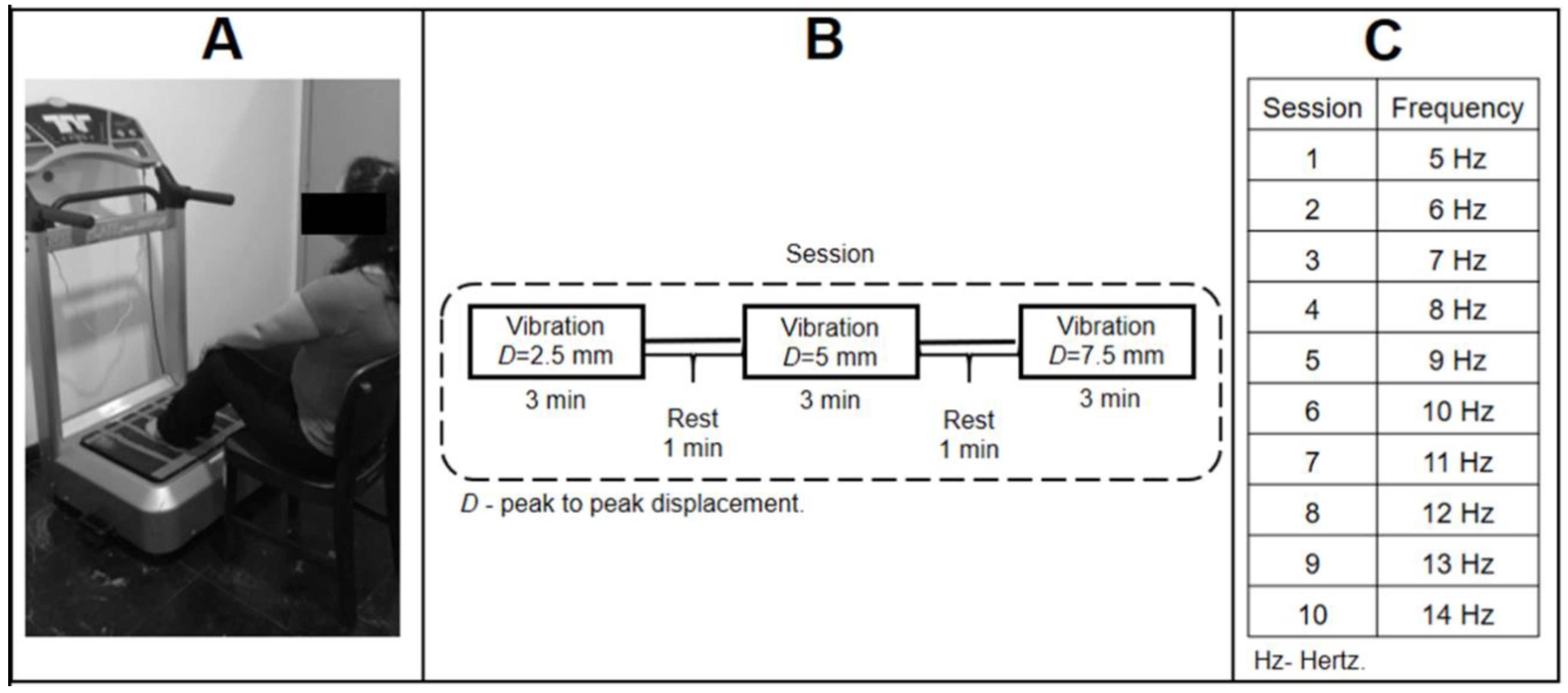
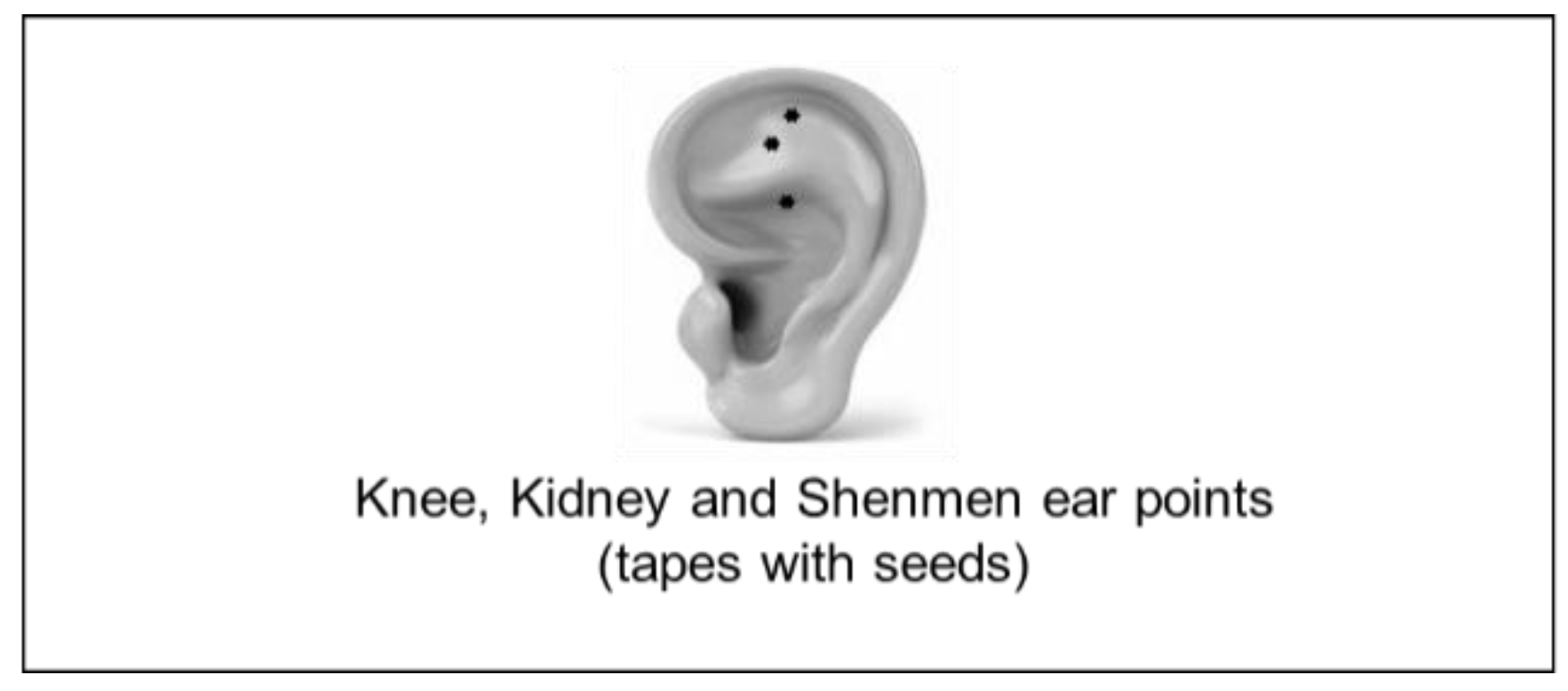
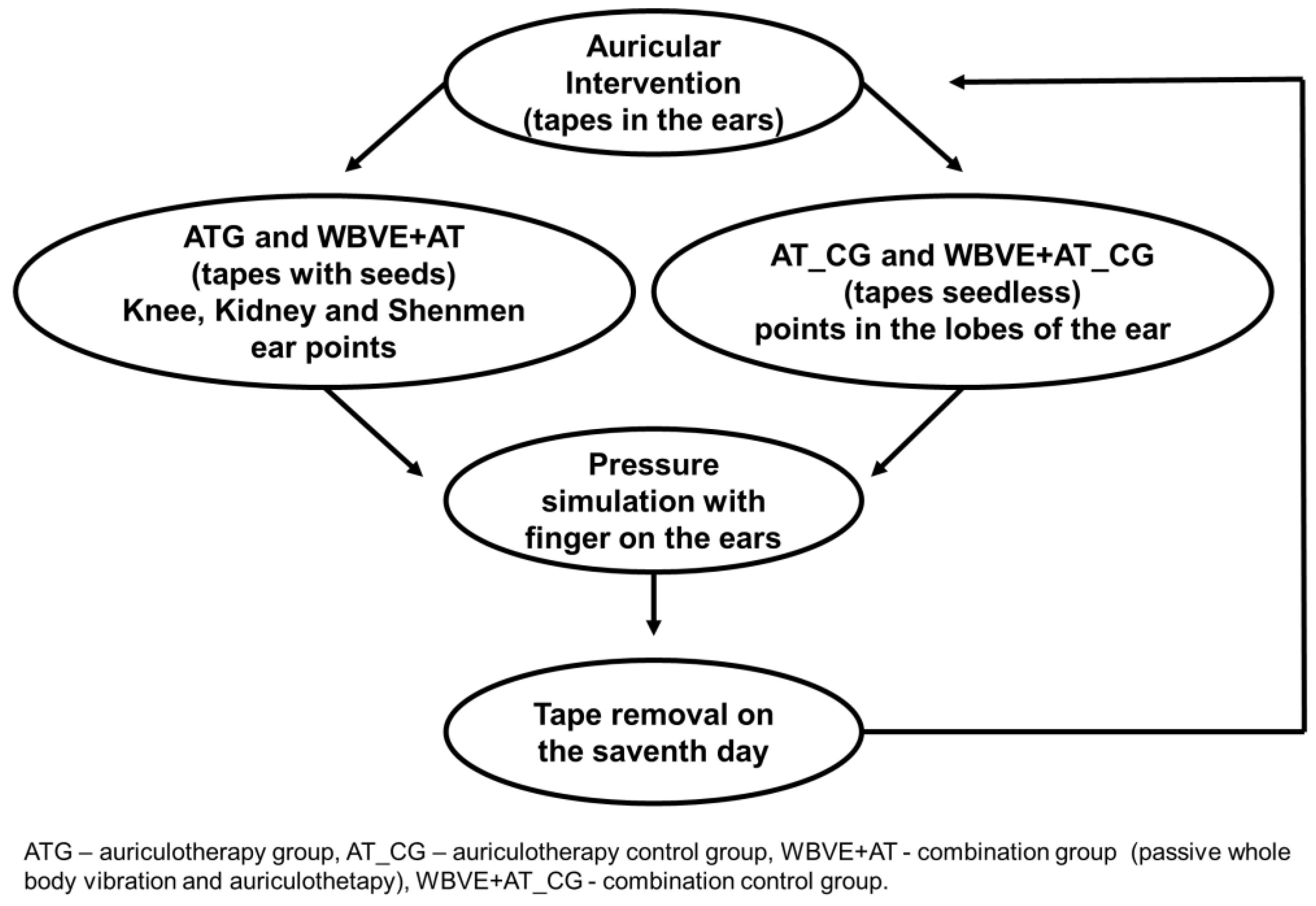
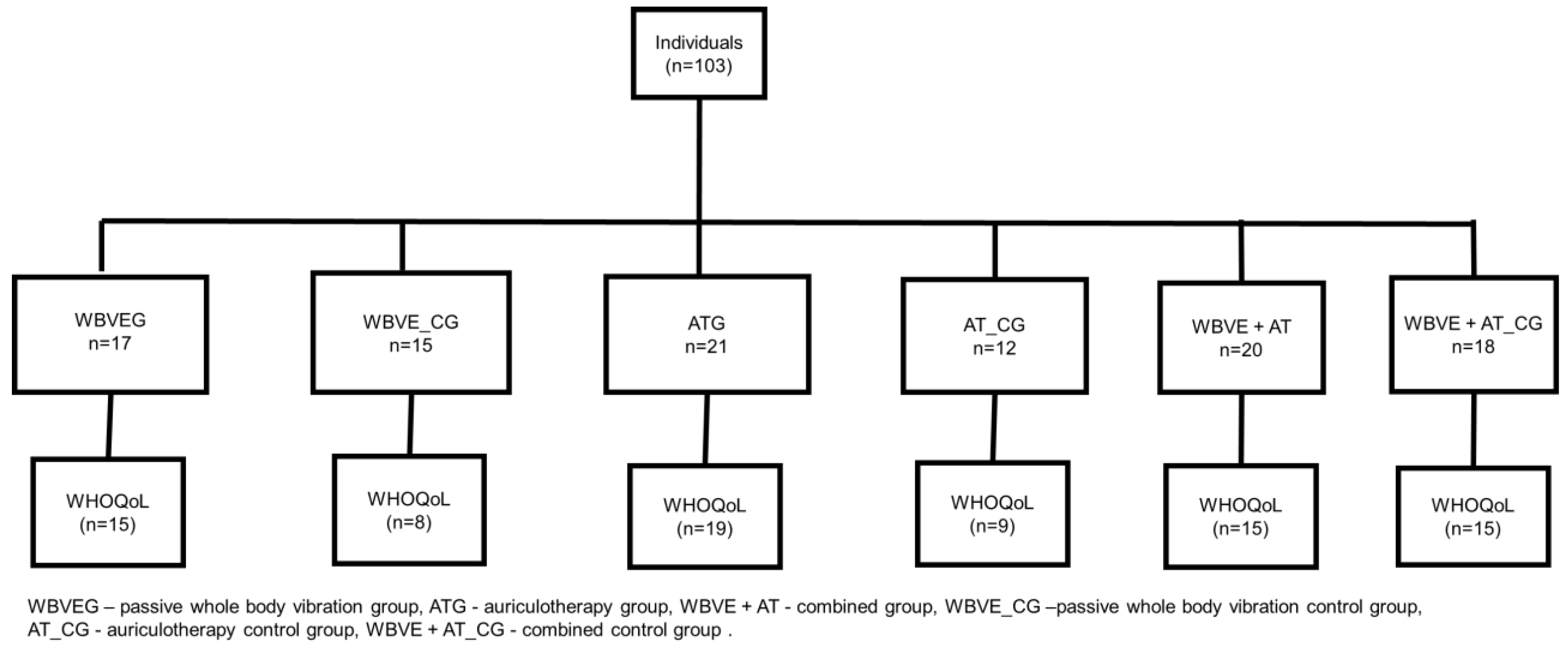
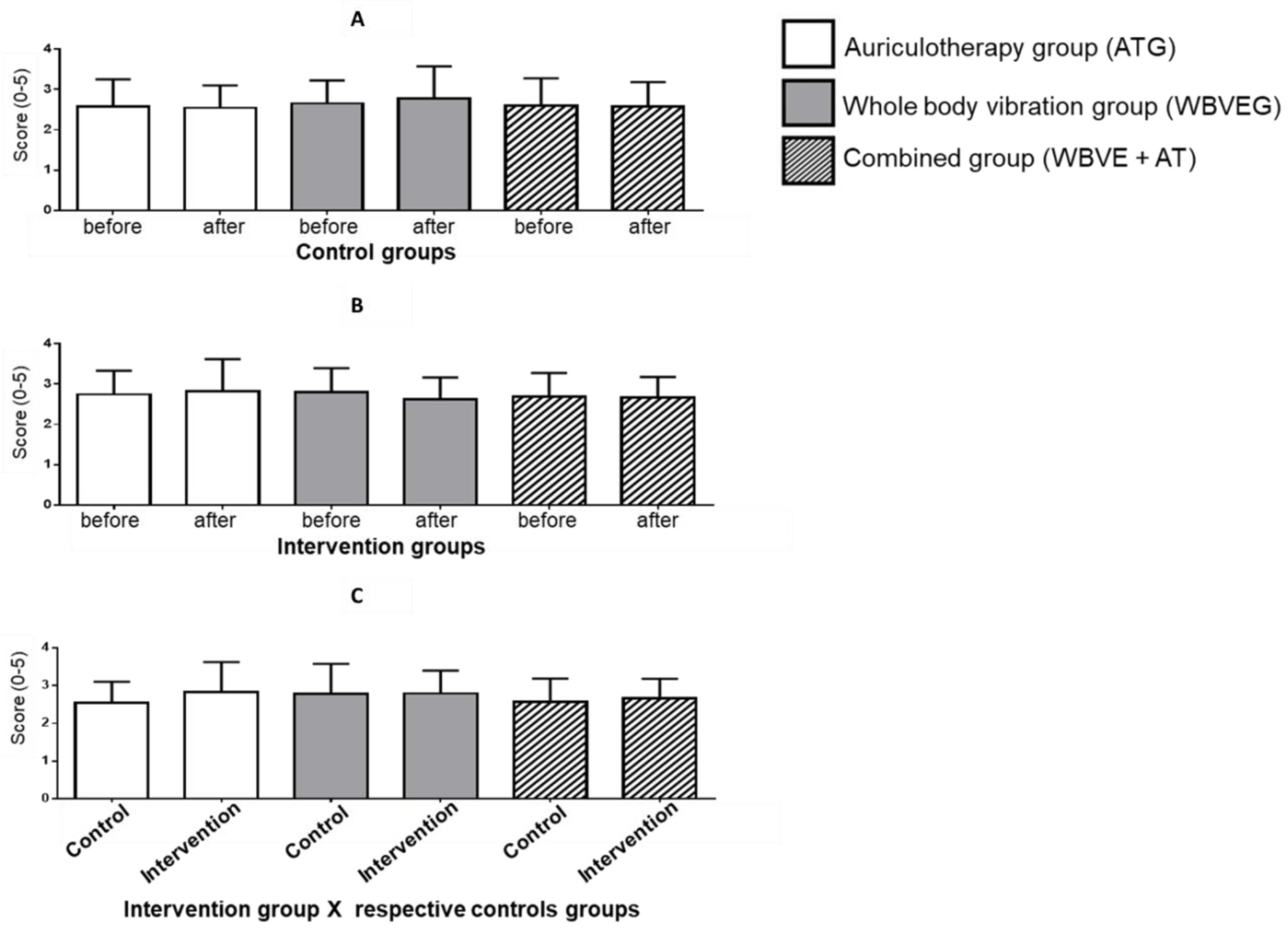
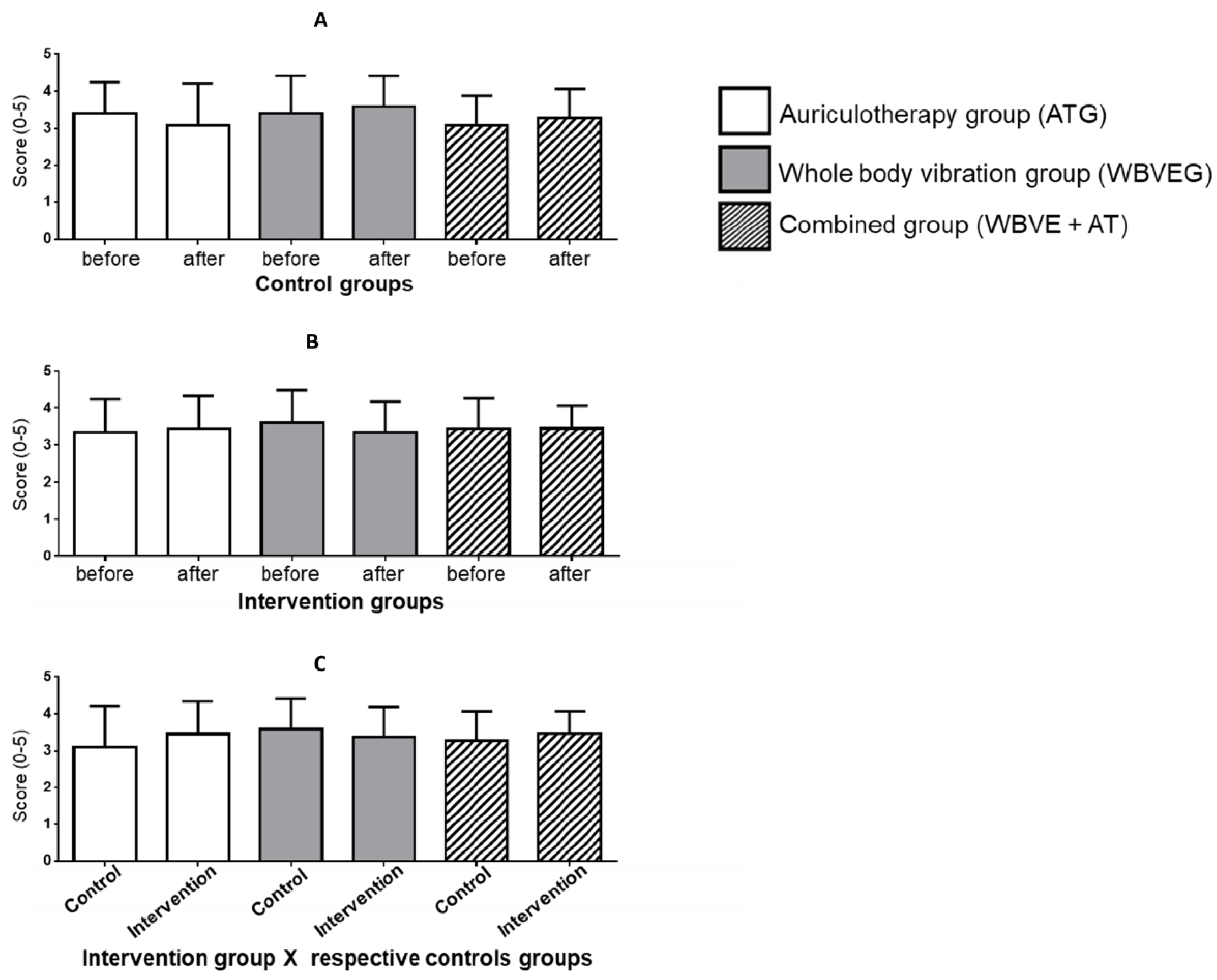
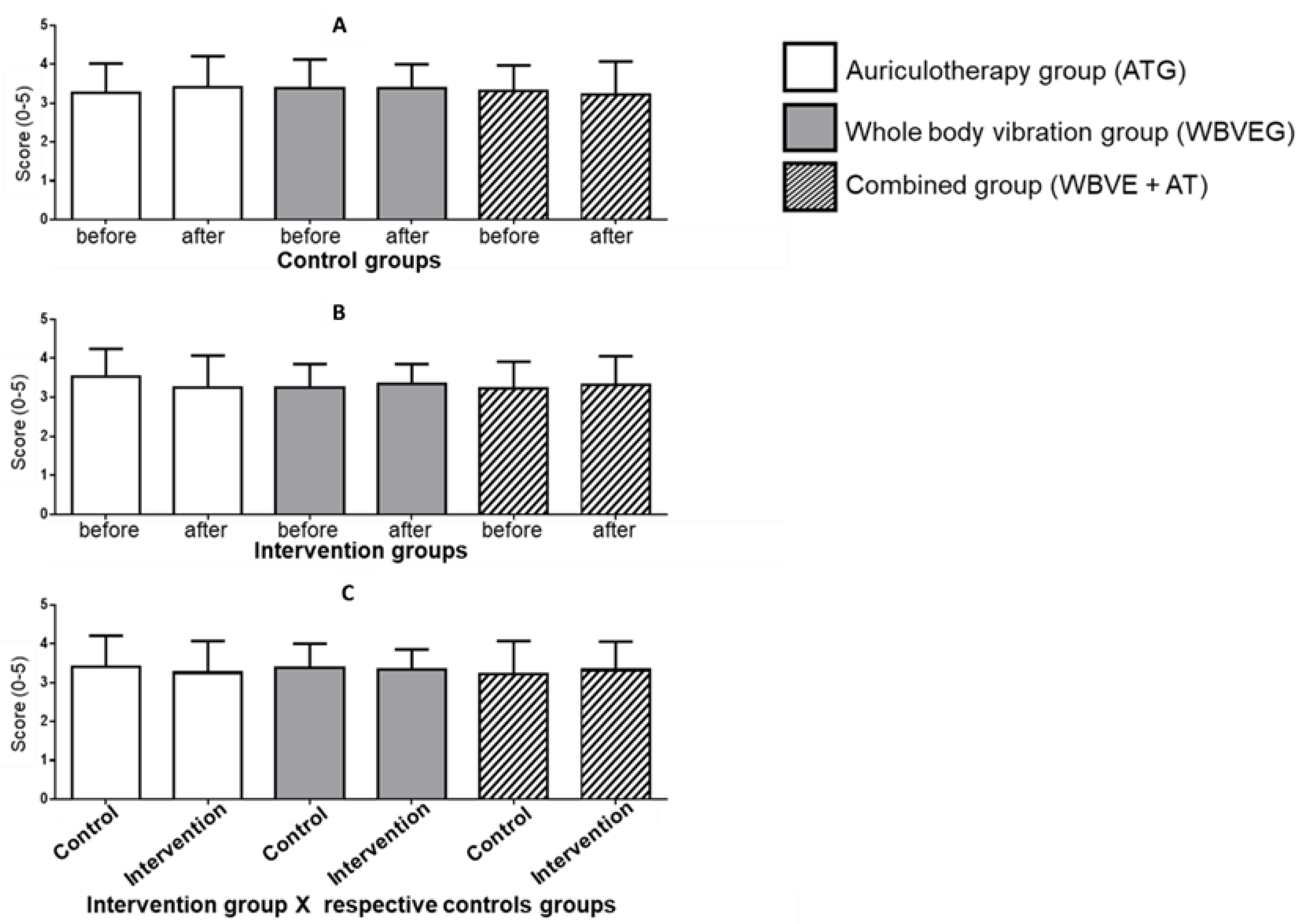
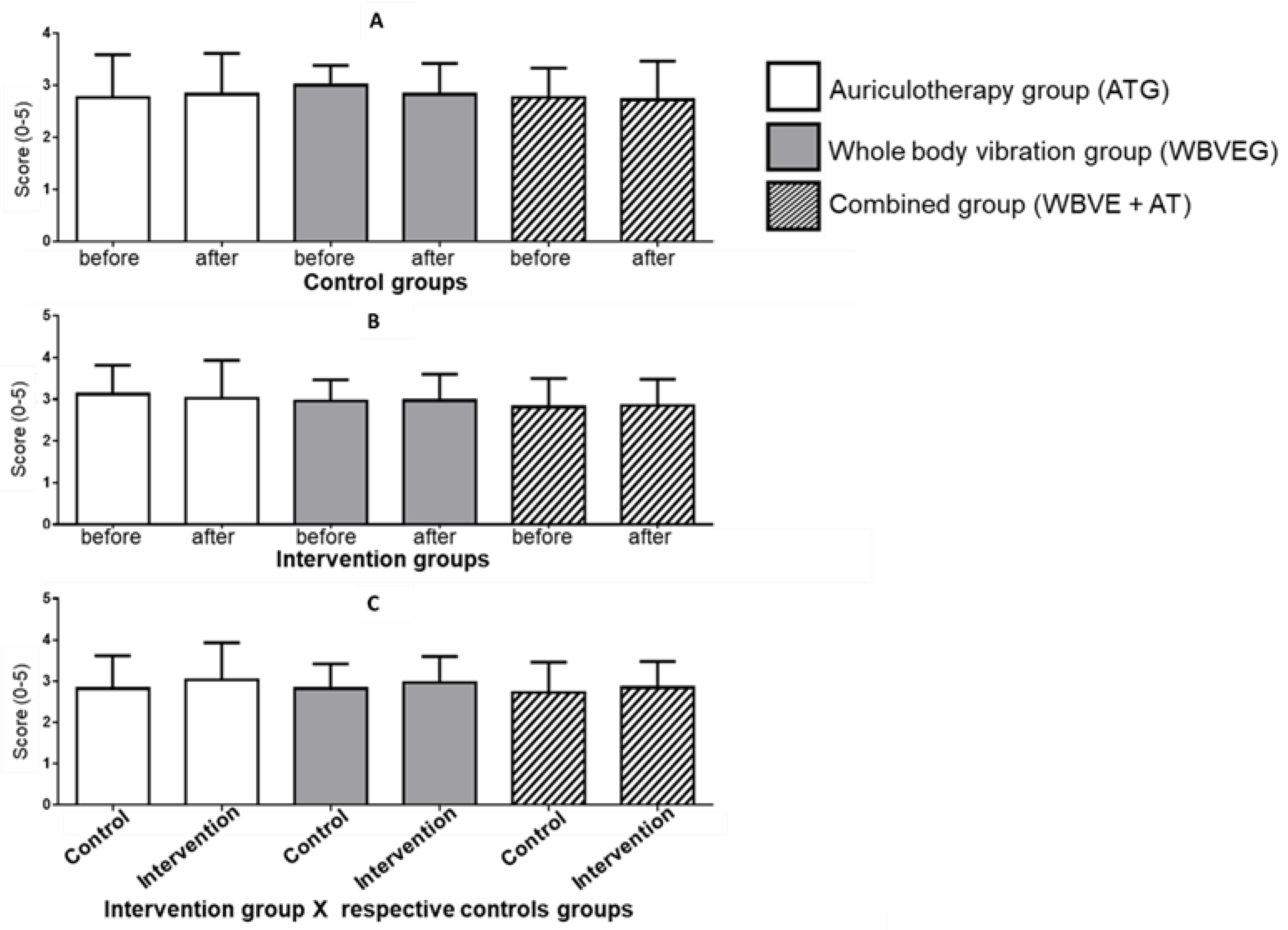
| Subjects (n = 103) | Mean (SD) |
|---|---|
| Age (years) | 65 (8) |
| Body mass (kg) | 85.65 (13.46) |
| Height (m) | 1.57 (0.07) |
| BMI (kg/m2) | 34.27 (7.99) |
© 2020 by the authors. Licensee MDPI, Basel, Switzerland. This article is an open access article distributed under the terms and conditions of the Creative Commons Attribution (CC BY) license (http://creativecommons.org/licenses/by/4.0/).
Share and Cite
Moura-Fernandes, M.C.; Moreira-Marconi, E.; Gonçalves de Meirelles, A.; Paula Ferreira de Oliveira, A.; Silva, A.R.; Felipe Ferreira de Souza, L.; Lírio Pereira da Silva, A.; dos Santos-Fernandes, C.; Bessa Monteiro de Oliveira, B.; Antonio de Souza Gama, M.; et al. Effect of the Combined Intervention with Passive Whole-Body Vibration and Auriculotherapy on the Quality of Life of Individuals with Knee Osteoarthritis Assessed by the WHOQOL-Bref: A Multi-Arm Clinical Trial. Appl. Sci. 2020, 10, 1956. https://doi.org/10.3390/app10061956
Moura-Fernandes MC, Moreira-Marconi E, Gonçalves de Meirelles A, Paula Ferreira de Oliveira A, Silva AR, Felipe Ferreira de Souza L, Lírio Pereira da Silva A, dos Santos-Fernandes C, Bessa Monteiro de Oliveira B, Antonio de Souza Gama M, et al. Effect of the Combined Intervention with Passive Whole-Body Vibration and Auriculotherapy on the Quality of Life of Individuals with Knee Osteoarthritis Assessed by the WHOQOL-Bref: A Multi-Arm Clinical Trial. Applied Sciences. 2020; 10(6):1956. https://doi.org/10.3390/app10061956
Chicago/Turabian StyleMoura-Fernandes, Marcia Cristina, Eloá Moreira-Marconi, Alexandre Gonçalves de Meirelles, Ana Paula Ferreira de Oliveira, Aline Reis Silva, Luiz Felipe Ferreira de Souza, Adriana Lírio Pereira da Silva, Carmen dos Santos-Fernandes, Bruno Bessa Monteiro de Oliveira, Marco Antonio de Souza Gama, and et al. 2020. "Effect of the Combined Intervention with Passive Whole-Body Vibration and Auriculotherapy on the Quality of Life of Individuals with Knee Osteoarthritis Assessed by the WHOQOL-Bref: A Multi-Arm Clinical Trial" Applied Sciences 10, no. 6: 1956. https://doi.org/10.3390/app10061956
APA StyleMoura-Fernandes, M. C., Moreira-Marconi, E., Gonçalves de Meirelles, A., Paula Ferreira de Oliveira, A., Silva, A. R., Felipe Ferreira de Souza, L., Lírio Pereira da Silva, A., dos Santos-Fernandes, C., Bessa Monteiro de Oliveira, B., Antonio de Souza Gama, M., Eduarda de Souza Melo-Oliveira, M., Guedes de Aguiar, E. d. O., Palmeira de Oliveira, L., Mozella, A. d. P., da Cunha de Sá-Caputo, D., Paineiras-Domingos, L. L., Pereira, M. J. d. S., Xavier, V. L., Lacerda, A. C. R., ... Bernardo-Filho, M. (2020). Effect of the Combined Intervention with Passive Whole-Body Vibration and Auriculotherapy on the Quality of Life of Individuals with Knee Osteoarthritis Assessed by the WHOQOL-Bref: A Multi-Arm Clinical Trial. Applied Sciences, 10(6), 1956. https://doi.org/10.3390/app10061956











